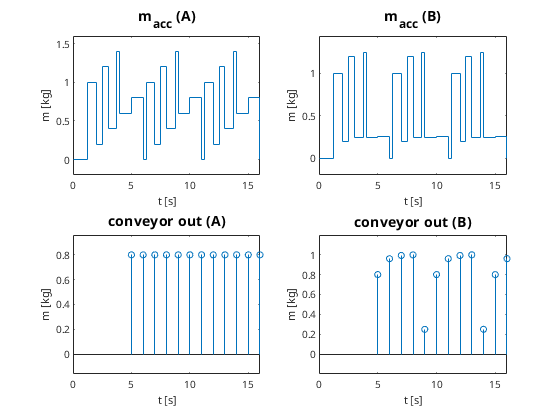Coupling of conveyors with different velocities
- Problem:
- two coupled conveyors, lengths l1,2 and
constant velocities v1,2
- continuous process for connected conveyors

- → simply change line load λ2 by factor
v1/v2
- discrete process with different lE1,2 and
∆t1,2
- conveyor 1 sends entities with time intervals ∆t1
- conveyor 2 outputs entities with time intervals
∆t2
- timing doesn't fit
- Basic idea:
- entity ≙ content of a given compartment on a conveyor
- created and filled at the entrance
- emptied and destroyed at the exit
- how to compute mass mout of a new entity
for conveyor 2?
- requirements
- mass conservation on short time scale
- homogeneity, i. e. output distribution similar to
input
- crucial parameter

- k > 1 → add up incoming masses to one
compartment
- k < 1 → distribute incoming mass to several
compartments
- simple case k∊ℕ → add up k incoming masses
- simple case 1/k∊ℕ → distribute incoming mass to 1/k
outgoing masses
- Strategy for k > 1:
- introduce virtual bin with mass macc
between conveyors
- incoming entities fill bin
- outgoing entity empties bin
- example
- lE1 = lE2 = 1 m, v1
= 2.5 m/s, v2 = 1 m/s, min ≡ 1 kg
- → ∆t1 = 0.4 s, ∆t2 =
1 s, k = 2.5
-
- Strategy A for k < 1:
- again virtual bin with mass macc between
conveyors
- each time min arrives: compute partition
mass mp
- mass of outgoing entity
- good example
- ∆t1 = 1 s, ∆t2 = 0.35 s → k
= 0.35
-
- very homogenous distribution
- bad example
- ∆t1 = 1 s, ∆t2 = 0.8 s → k
= 0.8
-
- macc grows → short time mass
conservation violated
- Strategy B for k < 1:
- like A, but changed partition size
- mp = k macc
- distribute the surplus of macc
- precise mathematical description in paper
- bad example (k = 0.8)
- comparison

- B: much better short time mass conservation
- A: better homogeneity























